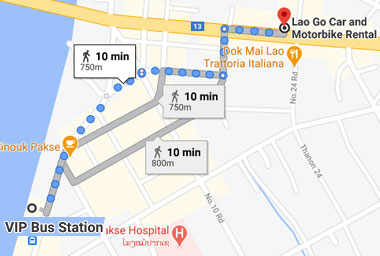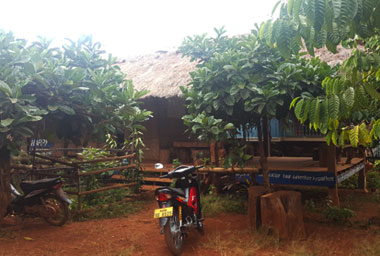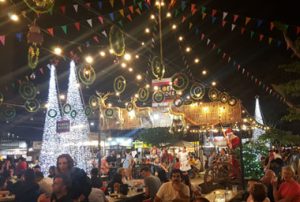Arriving in Pakse
We arrived in Pakse in the early hours of the morning. The bus journey took around 5-6 hours, so we got some decent sleep in. Today, we were planning on doing the ‘Pakse loop’, a loop route which would take us around a road with many interesting sights to see along the way. As the loop itself was around 200km, so it’s not something we wanted to do in a single day. The Candian dude we met in Thakhek advised us to do the loop and stop off at a village which was home to Captain Hook. Apparently it’s a must-do tour and will shock you, so we had to go and see it.
After getting off of the bus, our plan was to find a hostel that rented bikes. That way, we could leave our main backpacks in Pakse, whilst we rode around the loop, then come back and get them. This proved quite difficult, especially this early in the morning, bikes are in short supply! We queried a standalone bike shop about their services and our luggage. Thankfully, they frequently store luggage whilst people go on the Pakse loop, it was settled then! I can’t remember the exact prices, but automatic were quite a bit more expensive than semi-automatic, which we opted for. We hired a bike each, signed a disclaimer, and got all of our gear ready.


Refuelling for the day
Before we actually headed off, we went to a restaurant next door, for some breakfast. They had a wide variety of food, and all of our breakfast’s were delicious. Once we were full, we began our great adventure around the Bolaven Plateau (Pakse loop). I’d never ridden a semi-automatic bike before, but I quickly got the hang of it, in fact I preferred it over an automatic bike. After 1 wrong turn close to the beginning of our adventure, we were well on our way to the village that a certain Captain Hook lived in.
It was an extremely hot day, just the norm around here I suppose though. Most of the journey was unremarkable. Don’t get me wrong, it was great just speeding along the long and straight roads, with the countryside whizzing past you, and the odd settlement. Aside from these things, there was nothing noteworthy, but definitely pleasant. On the way to the village, we only stopped twice. One stop was for drinking the water, as well as sitting with a small family and a puppy, the other was for letting the water out the other end. The tours given by Captain Hook start at 8am, and 1:30pm. To our surprise, we arrived in his village, Bankokphoungtai, around lunch time, much earlier than we had anticipated.
Embracing the culture
We had a small amount of time to kill before the tour started, so we walked next door, where there was a homestay. This looked like a nice little place to stay, and a very friendly family, plus there weren’t any other options. You can’t miss it, as it’s right next to Captain Hook’s house, but it’s called the Somphone Homestay and Tour (they do their own tours). We got our rooms, which we were basically raised wicker huts, and dumped our stuff. The 3 of us then returned to Captain Hook, where a few others had gathered. Captain Hook had a large family, so many people of different ages, buzzing about.
He introduced himself before beginning the tour. The first stop was the coffee plantation. He talked about the coffee harvesting process, how to grow it, different kinds, how long to roast it for, basically everything about coffee! As a non-coffee drinker, I wasn’t too interested to be honest. What I found more interesting, was the red ants that were all over the trees here, quite large. He explained that due to the plants they feed on, it causes the ants to taste like lemon. As a willing volunteer, I tried one out first, and it did actually taste of lemon, very tasty! He also took us through a field in which he pointed out and explained most of the vegetation, and what uses they have. It’s amazing that each and every one of these plants/herbs has a use.




Culture shock
After touring around the plantations and fields, we were walked through the village. One of the customs of the village, is that adults may live with their parents until they die. In the most extreme case, over a hundred people lived in one house, and these aren’t large houses at all. You definitely have to have an open mind when it comes to these small village’s and their cultures. Other customs include kids smoking as early as 2 years old (apparently helps fend off the mosquitoes) and getting married as young as 8 years old (often to middle aged or old men). However, I believe due to the government wanting to bring the village to the modern era, they now have to be at least 16 years old or so.
The village is also very superstitious, and believes heavily in bad spirits which are accumulated by doing bad deeds. To counter these bad deeds, you must sacrifice animals, such as buffaloes, goats, and chickens. There’s also an event which involves the villagers kicking a puppy to death, seems harsh but they have their reasons, spiritual I believe. After all of this, we ended back at his house where we were offered the opportunity to have some of the freshest coffee you could acquire. I don’t drink it, so I kindly declined.
A well needed rest
After the tour had finished, we retreated to our homestay, next door thankfully. The heat and walking had taken it out of me, so I dived into my bed and had a nap. When I woke up it was getting dark. We were offered dinner and tea to drink, which was amazing, I couldn’t believe it. This friendly was so happy and friendly, it was great. After dinner, Mat, Mischa, and I played cards, along with an Austrian fellow called Beat. I also enjoyed interacting with the kids of the village, they’re very inquisitive and fun. Well after dark, we decided to dive behind the safety of the mosquito nets, and get some sleep.






